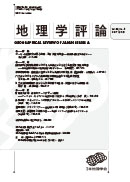Volume 90, Issue 5
Displaying 1-15 of 15 articles from this issue
- |<
- <
- 1
- >
- >|
ORIGINAL ARTICLE
-
2017Volume 90Issue 5 Pages 437-458
Published: September 01, 2017
Released on J-STAGE: March 02, 2022
Download PDF (1006K)
RESEARCH NOTES
-
2017Volume 90Issue 5 Pages 459-474
Published: September 01, 2017
Released on J-STAGE: March 02, 2022
Download PDF (1227K) -
2017Volume 90Issue 5 Pages 475-490
Published: September 01, 2017
Released on J-STAGE: March 02, 2022
Download PDF (1552K) -
2017Volume 90Issue 5 Pages 491-503
Published: September 01, 2017
Released on J-STAGE: March 02, 2022
Download PDF (1032K) -
2017Volume 90Issue 5 Pages 504-517
Published: September 01, 2017
Released on J-STAGE: March 02, 2022
Download PDF (1351K)
BOOK REVIEWS
-
2017Volume 90Issue 5 Pages 518-519
Published: 2017
Released on J-STAGE: March 02, 2022
Download PDF (430K) -
2017Volume 90Issue 5 Pages 519-523
Published: 2017
Released on J-STAGE: March 02, 2022
Download PDF (438K) -
2017Volume 90Issue 5 Pages 523-526
Published: 2017
Released on J-STAGE: March 02, 2022
Download PDF (436K) -
2017Volume 90Issue 5 Pages 526-528
Published: 2017
Released on J-STAGE: March 02, 2022
Download PDF (434K)
OBITUARY
-
2017Volume 90Issue 5 Pages 529-530
Published: 2017
Released on J-STAGE: March 02, 2022
Download PDF (626K)
MISCELLANEOUS RECORDS
-
2017Volume 90Issue 5 Pages 531-547
Published: 2017
Released on J-STAGE: March 02, 2022
Download PDF (966K) -
2017Volume 90Issue 5 Pages 548
Published: 2017
Released on J-STAGE: March 02, 2022
Download PDF (131K) -
2017Volume 90Issue 5 Pages 549-552
Published: 2017
Released on J-STAGE: March 02, 2022
Download PDF (240K) -
2017Volume 90Issue 5 Pages 553-554
Published: 2017
Released on J-STAGE: March 02, 2022
Download PDF (132K) -
2017Volume 90Issue 5 Pages 5_cover2-
Published: September 01, 2017
Released on J-STAGE: March 02, 2022
Download PDF (137K)
- |<
- <
- 1
- >
- >|
